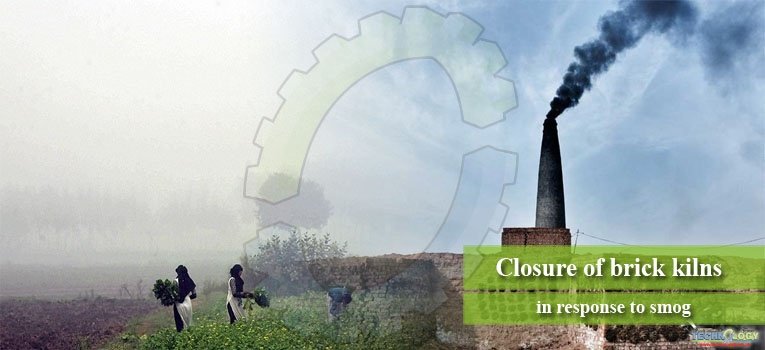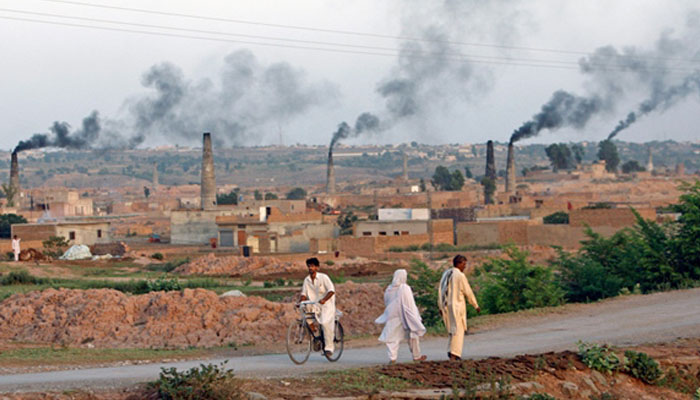Environmental pollution is one of the alarming conditions that are faced by majority of the countries. With the rapid increase in industrialization, the environmental degradation is also increasing . Brick making process releases may hazardous pollutants and increase smog.

Brick kiln emissions include following pollutants:
- COx
- NOx
- Sox
- Hydrocarbons
- Dust particulates.

EFFECT OF BRICK KILN EMISSIONS ON ENVIRONMENT OF PAKISTAN.
In Pakistan majority of the brick kilns are situated in in KPK, including Peshawar, Charsadda and Swat districts. Around 450 brick kilns are positioned in Peshawar and are the major cause of air pollution as a result of brick kiln emissions and vehicular emissions. The brick kiln pollutants as mentioned are produced as a result of coal, tyers and fuel gas that are used in manufacture of bricks.
The study was taken place in Peshawar to examine the consequences of pollutants such as heavy metals which are released from brick kilns and contaminate the soil and air pollution. This also causes food contamination and acid deposition. The main objectives of this study were:
- To estimate the heavy metal like Cd, Cr in the soil and plants in the surroundings of brick kilns
- The amount of dust particulate in the surroundings of brick kilns .
The results indicated that there was a high weight of dust with 23.8 to 46.0 gm-2 at 50 m distance from the chimney. This showed that brick kiln emissions have major pollution potential. The dust samples were analyzed and they indicated 2.65 mg kg -1 Cd and 16.6 mg kg-1 Cr average from all the four directions.
The conclusion was made from the study that heavy metals (Cd and Cr) are being added to the environment at a slow rate of 0.08 and 0.52 mg m-2 month-1 constantly .
The brick kiln emissions increase the amount of aerosol particles in the air. The increase in aerosol load is one of the potential cause of smog. Due to this the quality of air is declining to the dangerous level. In the recent report WHO has listed Lahore, Rawalpindi, Peshawar among the top 30 polluted cities in the world.
To initiate the burning process, the large amount of rubber are used for a brick kiln producing 80000 bricks. It also burns a total of 20drums of used vehicle oil and 8 ton of low quality coal. This procedure releases many toxic pollutants like oxides od nitrogen, CO and various dioxins. EPA in 2007 studied the rising number of brick kilns in Peshawar city of Pakistan, which has almost increased the level of air pollution two times (SOx, NOx and volatile organic compounds (VOCs)).
Health impacts.
Aldehydes and Free radicals are the carcinogenic dioxins and are lethal even in small amounts. This is causing reproductive health problems such as infertility in male brick kiln workers of all ages including children and adults, who are bound to work for prolonged periods.
60000 Pakistanis have died from the exposure to the high level of particulate matter in 2015 according to the report of WHO. The symptoms include itchy eyes, sore throat and difficulty in breathing. It has proved that air pollution causes mental issues like depression and Alzheimer’s.
Current situation and Government initiatives.
European Space Agency’s satellite has analyzed the data and generated the global list of 50 worst pollutant emission regions in which Lahore and the surroundings are ranked at 30th. Dangerous levels of nitrogen dioxide are detected in Lahore’s surrounding areas including Sunder and Jamber.
The higher levels of nitrogen are affecting the air quality of Lahore and affects are in the form of smog. Smog hits the major areas of Punjab each year before the onset of winter. The real time data on the air quality is provided by Pakistan Air Quality Initiative. In Punjab there are 11 air quality monitors but are unable to deliver their duties.
Brick kilns are not the only factor that is causing smog and air pollution but there are many other factors like vehicular emission, crop burning residues and industrial release etc. Government is still trying to find out the causes of smog. 11000 small and big brick kilns have been shut down recently this year before the start of smog season. The have given the deadline to replace their conventional brick kilns with the zigzag brick kiln technology.
This initiative is taken by Environment Protection Department, Punjab (EPD, Punjab and National Energy Efficient Conversation Authority in association with All Brick Kilns Owners Association of Pakistan. This technology is energy efficient and reduces sixty% of black smoke and fourty% of the particulate matter. The bricks baked are 90% ‘A’ class bricks however by conventional methods bricks are baked 60%. As compared to this the conventional brick kilns consumes:
- 90 to 180 tons of coal,
- 10 to 15 tons of wood and
- 4 to 6 tons of rubber per month.
Pakistan is focusing on this new environmental friendly and cost effective zigzag technology. Pakistan is also emphasizing on the project ‘Mitigating Black Carbon Emissions and Other Pollutants from Brick Production’ which encourages and creates such environment which leads to significant reduction in black carbon and other pollutants that are released from brick kilns. This project aims on the transformation of this sector into socially responsible, productive and profitable industry.